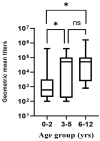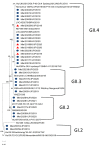Molecular Epidemiology of Norovirus (NoV) Infection in Mie Prefecture: The Kinetics of Norovirus Antigenemia in Pediatric Patients
- PMID: 35215766
- PMCID: PMC8880472
- DOI: 10.3390/v14020173
Molecular Epidemiology of Norovirus (NoV) Infection in Mie Prefecture: The Kinetics of Norovirus Antigenemia in Pediatric Patients
Abstract
Few studies have shown the presence of norovirus (NoV) RNA in blood circulation but there is no data on norovirus antigenemia. We examined both antigenemia and RNAemia from the sera of children with NoV infections and studied whether norovirus antigenemia is correlated with the levels of norovirus-specific antibodies and clinical severity of gastroenteritis. Both stool and serum samples were collected from 63 children admitted to Mie National Hospital with acute NoV gastroenteritis. Norovirus antigen and RNA were detected in sera by ELISA and real-time RT-PCR, respectively. NoV antigenemia was found in 54.8% (34/62) and RNAemia in 14.3% (9/63) of sera samples. Antigenemia was more common in the younger age group (0-2 years) than in the older age groups, and most patients were male. There was no correlation between stool viral load and norovirus antigen (NoV-Ag) levels (rs = -0.063; Cl -0.3150 to 0.1967; p = 0.6251). Higher levels of acute norovirus-specific IgG serum antibodies resulted in a lower antigenemia OD value (n = 61; r = -0.4258; CI -0.62 to -0.19; p = 0.0006). Norovirus antigenemia occurred more commonly in children under 2 years of age with NoV-associated acute gastroenteritis. The occurrence of antigenemia was not correlated with stool viral load or disease severity.
Keywords: ELISA; RNAemia; antigenemia; norovirus; real-time RT-PCR.
Conflict of interest statement
The authors declare no conflict of interest.
Figures





Similar articles
-
Norovirus RNA in serum associated with increased fecal viral load in children: Detection, quantification and molecular analysis.PLoS One. 2018 Jul 2;13(7):e0199763. doi: 10.1371/journal.pone.0199763. eCollection 2018. PLoS One. 2018. PMID: 29965979 Free PMC article.
-
Norovirus detection from sera of young children with acute norovirus gastroenteritis.J Clin Virol. 2016 Jun;79:6-9. doi: 10.1016/j.jcv.2016.03.021. Epub 2016 Mar 22. J Clin Virol. 2016. PMID: 27043968
-
Detection, genetic characterization, and quantification of norovirus RNA from sera of children with gastroenteritis.J Clin Virol. 2009 Feb;44(2):161-3. doi: 10.1016/j.jcv.2008.11.011. Epub 2009 Jan 7. J Clin Virol. 2009. PMID: 19131272
-
Emergence and predominance of norovirus GII.17 in Huzhou, China, 2014-2015.Virol J. 2015 Sep 11;12:139. doi: 10.1186/s12985-015-0370-9. Virol J. 2015. PMID: 26362650 Free PMC article.
-
Norovirus in Cancer Patients: A Review.Open Forum Infect Dis. 2021 Mar 14;8(6):ofab126. doi: 10.1093/ofid/ofab126. eCollection 2021 Jun. Open Forum Infect Dis. 2021. PMID: 34189156 Free PMC article. Review.
References
-
- Cannon J.L., Bonifacio J., Bucardo F., Buesa J., Bruggink L., Chan M.C., Fumian T.M., Giri S., Gonzalez M.D., Hewitt J., et al. Global Trends in Norovirus Genotype Distribution among Children with Acute Gastroenteritis. Emerg. Infect. Dis. 2021;27:1438–1445. doi: 10.3201/eid2705.204756. - DOI - PMC - PubMed
Publication types
MeSH terms
Substances
LinkOut - more resources
Full Text Sources
Medical

